May 27, 2013
by Carole Zangari -
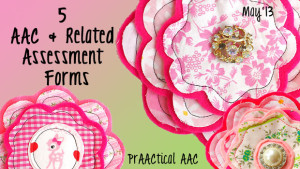
Ask any 10 professionals how they do AAC evaluations and you’re likely to get 10 different answers. We look for the same things (I think!) but go about it in different ways. We’re always happy to take a look at the protocols and forms that our colleagues develop and/or use. Here are some that might be of interest. 1. Bloom and Lahey Recording Sheet for staging language by Sherri Vernelso and Emily Pratt 2. Kate Ahern’s form for AAC device trials 3. SETT process assessment forms by HILIA Coordinators of Assistive Technology Services 4. The Functional Behavior Assessment Worksheet and Observation Forms by PaTTAN 5. Assessing the metaphoric use of pictures (e.g., Minspeak, Unity) protocol and forms by Gail Van Tatenhove If you have a protocol or form that you’d like to share, please get in touch. We’re always looking for new and better tools.
Filed under: PrAACtical Thinking
Tagged With: assessment, evaluation, forms, resources, testing
May 24, 2013
by Carole Zangari -
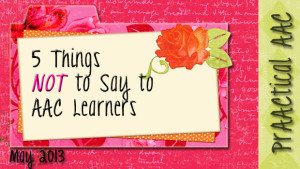
People who are learning to express themselves with AAC need to build their self-concept as competent communicators. One of the ways we can support that process is by being careful about the ways in which we refer to their communication. Here are a few things we try to avoid saying. “Show me [on your device].” (Instead, build the language of communication, with directives such as “Tell me” or “Say it.”) “Press the switch.” (Instead, refer to the function that the switch is being used for. E.g., “Make it go”) See Ian Bean’s great post on this subject. “Tell me on your talker.” (If they tell you one way, and you understood the message…celebrate, reward, and encourage! If you make them repeat themselves using a different strategy, they may come to view communication using AAC as a chore. And that’s not so good for motivation…) “I know you can do it.... [Read More...]
Filed under: PrAACtical Thinking
May 23, 2013
by Carole Zangari -
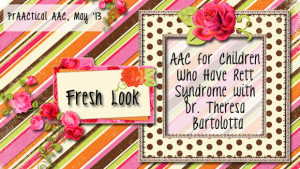
In our SLP training programs, few of us learned about Rett Syndrome or how to provide services to children with that disorder. We’re so pleased to have a guest post on AAC services for children with Rett by Dr. Theresa Bartolotta, Director of Assessment in the Office of the Provost, and Associate Professor in the Department of Speech-Language Pathology, at Seton Hall University, in South Orange, New Jersey. An SLP with over 30 years of clinical experience, she specializes in communication disorders in children with significant disabilities with a special interest in autism and Rett syndrome. Our field is still learning about Rett syndrome and we are still discovering new things about the range of skills and abilities present in the children who have it. In this post, Dr. Bartolotta gives us some background about the syndrome and discusses implications for treatment. I am thrilled to have this opportunity to post... [Read More...]
Filed under: PrAACtical Thinking
Tagged With: eye gaze, Rett syndrome, RTT, Theresa Bartolotta
May 22, 2013
by Robin Parker -
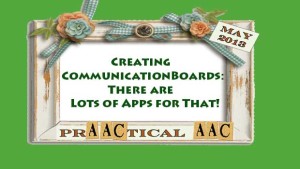
To continue on with the theme of the month, here are some app (and computer based) resources for easily creating your own communication boards: Pogo Boards Pogo Boards is a communication board creator for both the computer and the iOS platform. You can make traditional grid-based communication boards and a variety of other visual supports. Pogo Boards also has a variety of pre-made boards that users share. Price: – Free trial period with premium account, then Free basic account, Subscription price for ongoing premium account Symbly Go & Symbly Symbly is a computer based communication board creator. Communication boards are super easy to create, share, and print out. Symbly Go is an iOS platform app that allows you to view your communication boards (and other visual supports) on your iPad. Your communication boards will automatically be downloaded to your iPad (even when there’s no Internet connection available). There is text to speech capability if... [Read More...]
Filed under: PrAACtical Thinking
Tagged With: Apps, communication boards, resources
May 21, 2013
by Robin Parker -
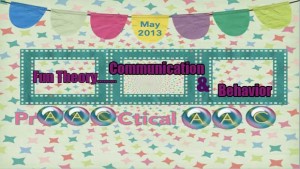
Please excuse this somewhat tangential post because it really relates to communication and language learning….. Fun and communication go together. Meaningful (and fun) communication and language activities can often make the difference between a disengaged passive learner and a participatory, engaged, and excited learner. We have talked about many picture symbol communication boards, but there are also tangible and tactile communication boards that have been essential for learners that have vision impairments as well as those who have difficulty discriminating between picture symbols. While exploring a variety of communication boards, we came across Adaptive Design Association Inc. Adaptive Design Association Inc. reminds and teaches us about the role of appropriate customized adaptions to allow for authentic communication, developmental, social, and academic learning (who knew what you could do with cardboard?). Within our search through adaptive design, there was a link or connection to the fun theory. Fun can change behavior for EVERYONE and... [Read More...]
Filed under: PrAACtical Thinking
May 20, 2013
by Carole Zangari -
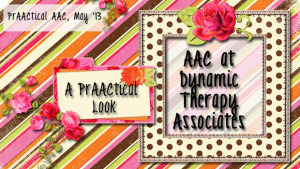
We’re so excited to continue our PrAACtical Look series with a guest post from Vicki Clarke, who is the CEO of Dynamic Therapy Associates, a speech language therapy clinic in Kennesaw, Georgia. Vicki specializes in AAC, conducting local and national device evaluations, consultations, treatments and trainings for individuals, clinics, school systems and professional organizations and manufacturers. Vicki has a wealth of knowledge in the prAACtical aspect of AAC service provision and shares a tiny bit of that with us in this post about preparing clients who use AAC for medical encounters. :::::::::::::::::::::::::::::::::::::::::::::::::::::::::::::::::::::::::::::::::::::::::::::::::::: I was asked to contribute a “favorite therapy activity” kind of post to this blog a few months ago. Decisions, decisions, decisions….I love Arts & Crafts Therapy, Cooking Therapy, iPad Therapy, Shopping Therapy, and Hang-Around-And-Chat Therapy but what to share? I mulled it over and I decided on “Serious Medical Procedure Preparation Therapy.” Fun stuff, right?!!? We do a lot... [Read More...]
Filed under: PrAACtical Thinking
Tagged With: device customization, Dynamic Therapy Associates, Medical, patient care, SGD programmming, Vicki Clarke
May 17, 2013
by Robin Parker -
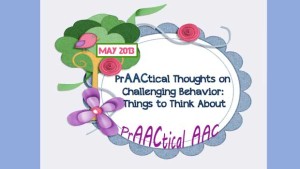
We have had several experiences in the last couple of weeks relating to concerns from SLP’s and educators about challenging behavior (dare we say it might be less structure, less predictability, less routines, or just plain tiredness because it is the end of the school year). Challenging behavior is hard… and disconcerting especially if you feel that you have little control over it (imagine how the learner feels- almost no one wants to be unhappy and out of control). However, there are so many strategies and supports that can improve the situation. It is often about getting back to basics (especially if end of the year issues play into the challenging behavior). The First 5 Questions to Ask: How Does the Learner Communicate? It is important that everyone has a way to communicate their own wants, needs, ideas, interests, and more. It is NOT good enough to just ‘know’ what someone... [Read More...]
Filed under: PrAACtical Thinking
Tagged With: behavior, Challenging Behavior, visual supports
May 16, 2013
by Robin Parker -
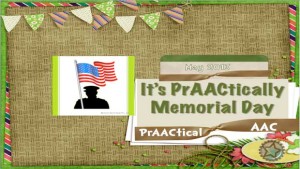
It’s PrAACtically Memorial Day! Memorial Day is prAACtically here. We remember, appreciate, and honor the people who have protected our freedoms. Getting ready so EVERYONE can participate is important. We wrote about memorial day last year and had found some good gluten-casein free Memorial Day recipes. There are even more resources today. Check out Gluten Free Memorial Day Weekend Menu and Recipe Ideas or Gluten Free Casein Free Applesauce Muffins. Cooking and baking provide meaningful language experiences as well as just plain fun. There are symbol based recipes on Pinterest at Picture Recipes and Visual Recipes for Children with Autism, and at Specialty Chef. There are also prAACtical AAC ways to teach about Memorial Day’s meaning as well as the typical memorial day vacations, activities, and events. Learning about Memorial Day Memorial Day Activity Board Memorial Day Vocabulary Cards Memorial Day Bingo Memorial Day Adapted Bingo Summer Pack Memorial Day After learning about Memorial... [Read More...]
Filed under: PrAACtical Thinking
Tagged With: calendars, meaningful language experiences, Memorial Day, resources, schedules, social stories, talking photo albums
May 15, 2013
by Carole Zangari -
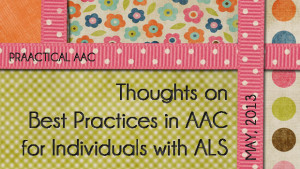
We’re always gratified by the collegiality of SLPs who work in AAC. In this video, Steven Bloch talks about the need for professionals to have real dialogue about clinical intervention and best practices. He shares his experience of organizing a group of professionals to develop best practice guidelines for working with people who have ALS/motor neuron disease. This brief presentation was recorded at a Therapy Ideas Live event at the Google campus in London this past March. You can access the material developed by Bloch and his colleagues here.
Filed under: PrAACtical Thinking
Tagged With: ALS, best practices, motor neurone disease
May 14, 2013
by Robin Parker -
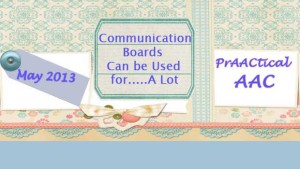
We have been thinking about communication boards this month. There are a lot of pre-made options available. You just have to check and make sure the pre-made options meet the individual needs of your learners. If not, they are often a good place to start while taking the time to modify and develop specific individual communication boards. Check out these 5 great resources for pre-made communication boards: Speaking of Speech- Play-Based Communication Boards Communication Board for Lunch AAC Topic Setting Conversation Boards Child’s Play Communication Boards Show & Tell Free AAC: Communication Boards for Adults Communication Boards for Hospital Stays Bedside Communication Board Alphabet Board & Yes/No Accident and Emergency Communication Board (Also many children AAC Communication Boards available) Boardmaker Share Walk Communication Board Rehab Communication Board Doll/Play Communication Board FTLU Golf Communication Board (Many more communication boards, search by topic) Autism Teaching Strategies Talk to Sister Talk to Dad... [Read More...]
Filed under: PrAACtical Thinking
Tagged With: communication boards, resources









